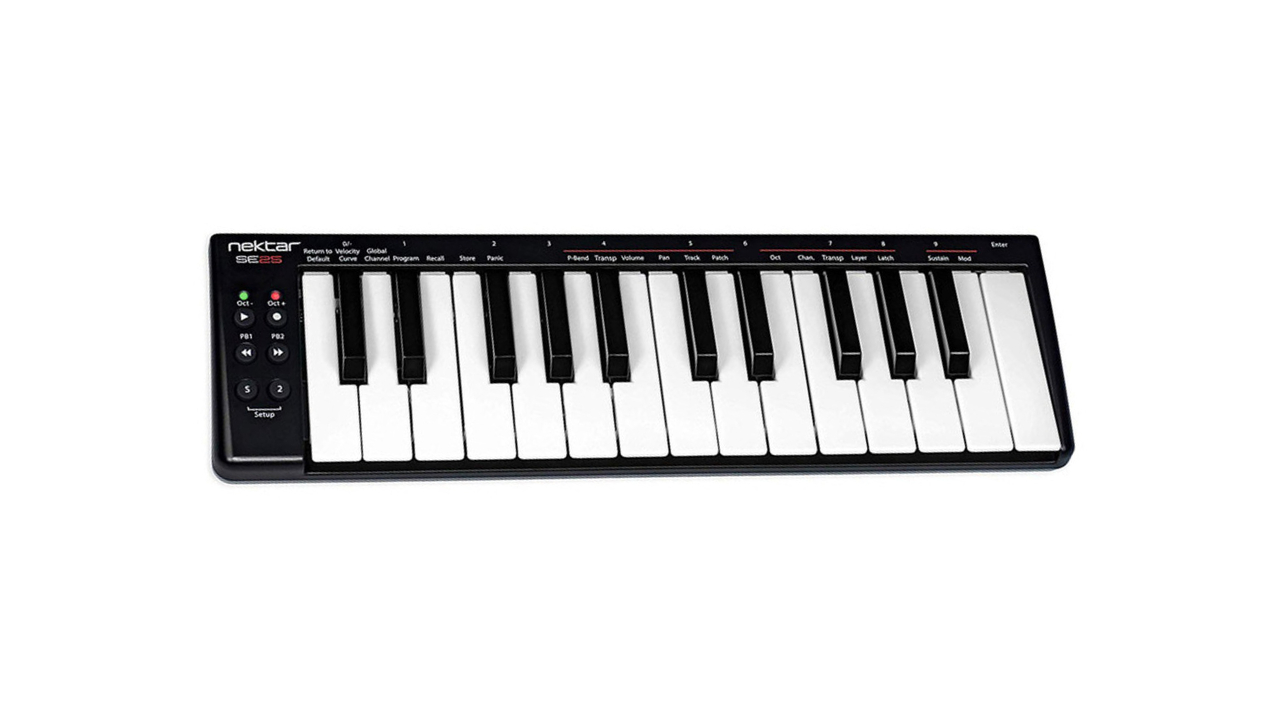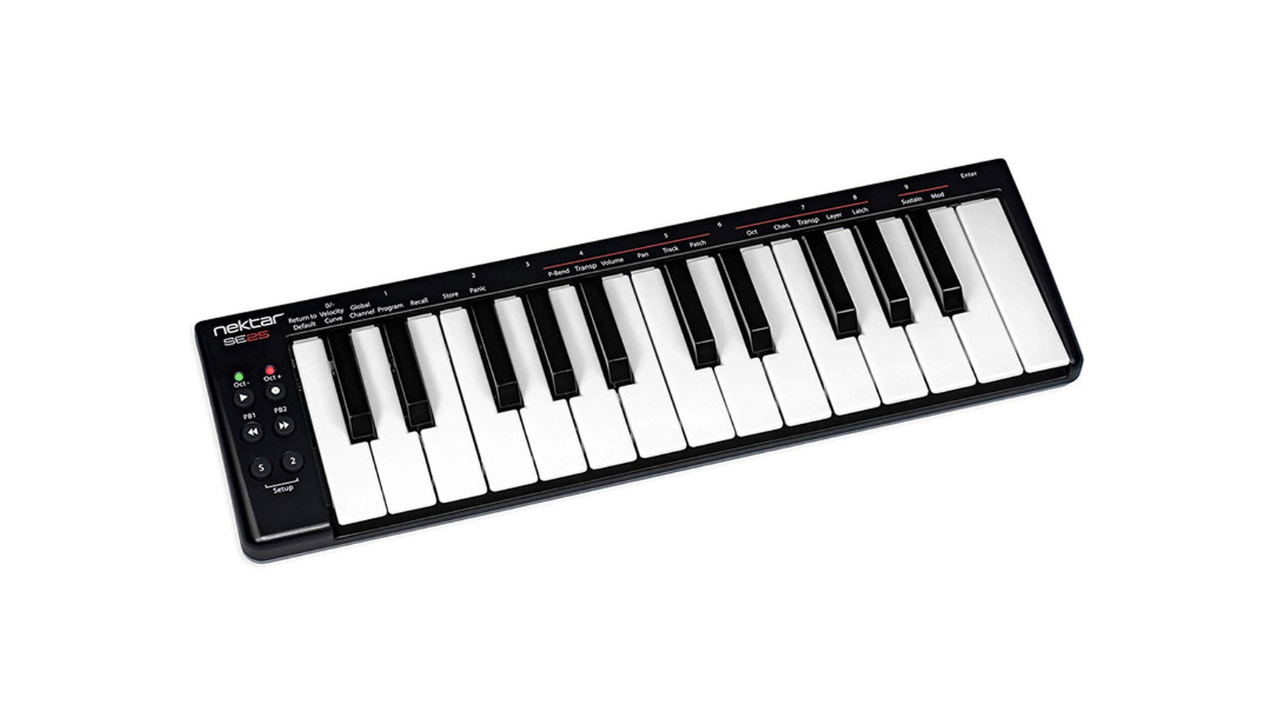MusicRadar Verdict
The Nektar SE25 packs a lot more punch than its size promises. Barely bigger than the keyboard itself, the SE25 slots in nicely in front of your laptop (it will be about the same width) and gives you pretty unprecedented level of control at this price point and level of portability. There's much control to be had if you dig deep and even on a simple level it will hook up to most DAWs with ease. A great mobile controller.
Pros
- +
Incredibly small footprint and light
- +
Lovely multi-functionality
- +
Good keyboard for the size
Cons
- -
You'll need the manual for some of the deep operations
- -
'Players' will want a better keyboard
MusicRadar's got your back
Nektar SE25 review: What is it?
Mini controller keyboards are an essential part of the mobile musician's studio. Yes, you can get away with just using a laptop for music production, but the keyboard feel and extra MIDI control open up the experience to be more about creativity rather than wrestling with a mouse and trackpad. Mini keys are just about as small as you can get a playing experience to be, 25 of them being a minimum. You can see, then, that the Nektar SE25 on test here, just about manages to wrap enough controls around 25 mini keys to be one of the smallest and most flexible MIDI keyboards on the market.
The keyboard is lightweight too, just 400g, which is almost ridiculously light for a playable keyboard, so will fit anywhere – not quite your pocket, but any shoulder bag. It comes with a USB cable to get its power and is bundled with Bitwig's 8-Track software, a very decent version of Bitwig's groundbreaking DAW which will give newcomers to music making a great introduction to the world of computer-based music making.


Nektar SE25 review: Performance & verdict
Connections are minimal, just a micro-USB port which is what you'd expect given the keyboard's dimensions – no extra pedal inputs here. Controls, too, are basic but very functional as they can often be assigned to or double up to other functions. As a standard controller the top two buttons are Octave Up and Down and beneath these you get PB1 and PB2 buttons which are initially set to pitch-bend. However, these can also be assigned to one of six other functions P-Bend, Transp, Volume, Pan, Track or Patch) and you'll need to make sure you are in Setup mode to do this (press the two bottom buttons until the LEDs blink). Then simply select one of the six options which are named above specific keys on the SE25 keyboard. Select Volume, for example, and PB1 and PB2 will send decreasing or increasing MIDI volume data to your MIDI instrument; select pan and it works the same way. This might sound more complicated than it actually is in operation; you simply have to remember to put the keyboard in Setup mode before selecting your option and then it becomes very intuitive.

Akai LPK25
Alesis V-Mini
Korg microKEY-25
The S button below is easier to understand; it just acts either as a Sustain or Modulation option, again using keys on the keyboard to select which. The 2 button is a little more unique, though. It is assignable, again by way of keys on the SE25's keyboard, this time to options titled Oct, Chan, Transp, Layer and Latch. These functions are pretty self explanatory but pressing the 2 key brings in each instantly, to give you different performance or MIDI options. Release it and the SE25 reverts back to the original setup. You can add a note two octaves above the one you are playing, for example, or add a harmony layer, latch notes or switch to a different MIDI channel. You will have to dig a little deep in the manual to learn how to program how each performance takes place but this is an in-depth and very welcome feature for such a cheap MIDI keyboard. Hats off to Nektar for its successful implementation in such a small-form device.
Finally on the control front, press Play and Rewind together and the buttons will function as their assigned transport controls according to the graphics in them: play, record, rewind and fast-forward.
The Nektar SE25 keyboard itself is playable, not the greatest experience for 'proper' players of course, but when you're on the move this will be all you need: a means to input beats and notes with velocity sensitivity. If you need something bigger and more playable, you'll need to return to the studio and get your wallet out, simple as that.
Nektar SE25 review: Hands-on demos
Nektar
John Mike
Nektar SE25 review: Specifications
- Compatibility: PC, Mac
- No of Keys: 25
- Key size: Mini
- Key type: Velocity sensitive
- Controls: 6 function buttons: 2 x assignable PB buttons, one assignable Part 2 button, S button for sustain and modulation
- Power: via USB
- Software: Bitwig 8-track DAW
- Dimensions (WxDxH): 335 x 100 x 21
- Weight (kg): 0.4
- Contact: Nektar
- Start creating with the best beginner MIDI keyboards
Want all the hottest music and gear news, reviews, deals, features and more, direct to your inbox? Sign up here.
Andy has been writing about music production and technology for 30 years having started out on Music Technology magazine back in 1992. He has edited the magazines Future Music, Keyboard Review, MusicTech and Computer Music, which he helped launch back in 1998. He owns way too many synthesizers.

